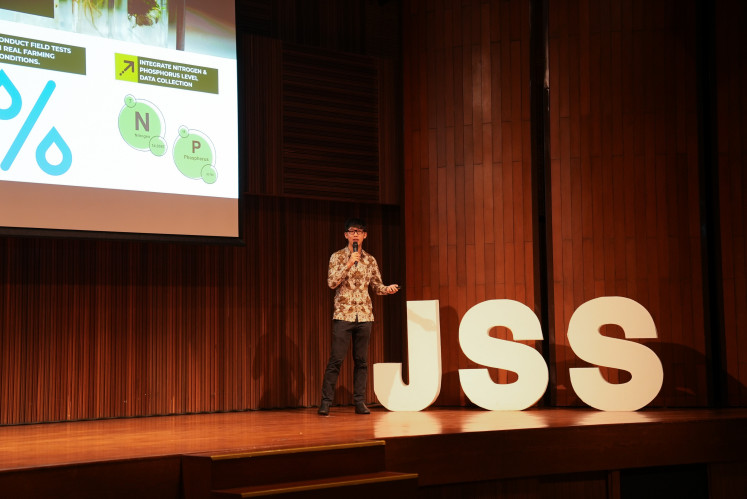Thriving in an uncertain future
Change text size
Gift Premium Articles
to Anyone
 (Source: Midjourney/Aldinabahri)
(Source: Midjourney/Aldinabahri)
I
n today’s era, marked by disruptive innovation that demands strategic acumen, leaders and managers play a pivotal role in orchestrating strategies to navigate the turbulent waters.
In coping with this uncertain future, companies commonly look at the strategic, the organizational and the individual level.
At the strategic level, companies grapple with the challenges of operating in a world characterized by constant change and unpredictability.
Crafting a robust strategy involves making decisions regarding target customers, product offerings and distribution channels.
The conundrum lies in the fact that, as these decisions are made, the external environment undergoes unforeseen transformations, presenting organizations with unexpected challenges.
Therefore, the strategic challenge is delicately balancing between providing a clear organizational direction and maintaining the agility to adapt to the ever-changing environment.
Striking this balance is crucial; otherwise, organizations risk becoming entangled in confusion.
The dichotomy between being overly prescriptive and overly reactive presents leaders with the intricate task of charting a course that provides direction without stifling adaptability.
To navigate these choppy waters and find equilibrium, one needs to depart from making grand, future-defining bets. Instead of placing monumental wagers on the future, leaders are encouraged to embrace a strategy of making a series of smaller, iterative bets.
Each small bet, when proven correct, propels the organization in the right direction, creating a cumulative and agile trajectory.
An example that epitomises the power of small bets is the evolutionary strategy adopted by Amazon.
Initially focused on book retailing, the company progressively expanded its offerings to encompass a vast array of products and services, including cloud computing and streaming. This strategic evolution through a series of smaller bets has been instrumental in Amazon's global success.
Culture of experimentation
Furthermore, in the face of uncertainty, the mantra shifts from guessing to learning. The days of relying solely on market analysis and investing substantial sums in a particular direction are over. Instead, leaders are encouraged to adopt a culture of experimentation.
Rather than sitting in contemplation, leaders should conduct small experiments to test hypotheses, learn from outcomes and iteratively build on successes. Google stands as a testament to the power of continuous experimentation.
The company's culture encourages employees to spend time on side projects, fostering an environment of perpetual learning and experimentation that has led to groundbreaking innovations such as Gmail and Google Maps.
Meanwhile, at the organizational level, companies must become an agile organization in a fast-changing world. It is no longer sufficient for leaders to proclaim a change in direction; a cultural shift is required.
Individuals within the organization must be willing to adapt, and structures and processes must be adjustable to accommodate these changes.
Agility, once considered a useful characteristic, has evolved into a necessity. Agility, in this context, requires a rapid recognition of changes unfolding in the external environment.
Leaders must possess the acumen to spot emerging trends and respond promptly. Waiting for prolonged periods while events unfold is antithetical to agility. The need is to recognize early that change is afoot and to swiftly evaluate and implement necessary adjustments.
An illustrative example of organizational agility is reflected in Spotify's adoption of the Agile framework. The company's organizational structure, comprising autonomous squads, tribes, and chapters, facilitates quick decision-making and adaptation, allowing for rapid responses to market changes.
Crucial to organizational agility is the need for autonomy to be embedded in the company's DNA.
Leaders must instil behaviors that promote agility in day-to-day activities. One essential element is providing autonomy to individuals within the organization, allowing them to monitor, assess and respond to local changes without waiting for central directives. Chinese appliance manufacturer Haier's entrepreneurial management model exemplifies the integration of autonomy.
Haier's employees act as individual entrepreneurs, making decisions independently based on local market dynamics. This decentralized decision-making empowers frontline employees to act swiftly and effectively, contributing to Haier's global success.
At the individual level, the emphasis should be put on cultivating individuals who are willing to adjust behaviors and modify beliefs.
Operating on outdated assumptions hampers both personal growth and organizational adaptability.
The external environment, in constant flux, necessitates a proactive approach to updating beliefs and behaviors. Since the external environment has changed – and is changing all the time – there is a high probability that many of the things we have taken for granted until now are no longer valid.
To navigate this ever-changing environment, first of all, naturally, we must want to and able to be humble enough to recognize that the external environment has changed, and must question the validity of long-held beliefs. This means asking ourselves, “How can I assess which of my beliefs are still valid and which ones I need to adjust?” An example is, if like a leader who was brought up in previous decades, we might believe that we should behave in a completely hierarchical way and tell people what to do, because that is what successful bosses do.
Is that belief still valid? Or is hierarchy not as important now as it was a few decades ago? How are other leaders behaving? If they are behaving in different ways and being successful, it might mean that we have to start managing people in different ways.
We all need to question, reconsider and be willing to change beliefs and behaviors at the individual level so that the company is agile at the organizational level.
In conclusion, navigating the waves of disruptive innovation demands a holistic approach that integrates strategic acumen, organizational agility and individual adaptability.
The success stories of globally renowned companies underscore the importance of embracing experimentation, fostering autonomy and continuously reassessing beliefs and behaviors.
The journey is ongoing, and those who emerge as winners are the ones who navigate with curiosity, adaptability and a commitment to continuous improvement.
As the landscape of disruptive innovation evolves, the key lies not just in responding to change but in proactively shaping it, transcending the boundaries of uncertainty to thrive in an ever-transforming global and local environments.










